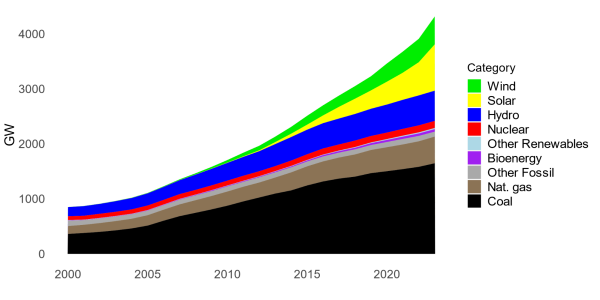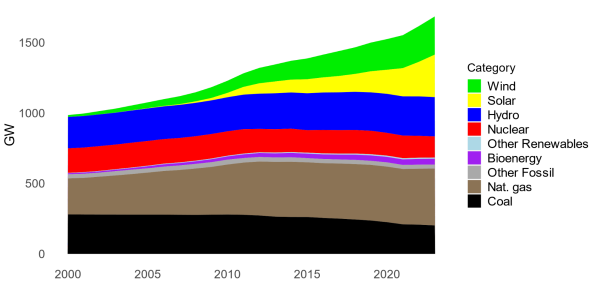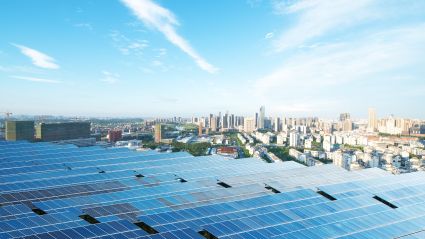
The 2016 Paris Agreement set greenhouse gas reduction targets for nearly every country in the world with the goal of limiting global temperature, which has been rising rapidly since 1980. According to most experts, the most viable roadmap to significantly reducing or eliminating carbon emissions is to decarbonize electricity while electrifying other activities that use fossil fuels, such as transportation, heating, and heavy industry.
As documented in our recent report, over the past ten years the US has substantially increased its use of carbon-free sources of electricity. This growth has been largely driven by a surge in wind energy and, even more so, solar energy capacity. As of December of 2023, wind was still the largest source of carbon-free electricity in the US, but solar capacity is surging and is expected to surpass wind by the end of 2024.
Figure 1: Electricity Capacity, by Energy Source
United States

The World

Asia

Note: All capacity data in this article comes from the climate think tank Ember. https://ember-climate.org
Despite this progress, the US is still below the world average in its share of solar electric capacity. Solar power is on the rise in much of the rest of the world, with many Asian countries leading the way in solar energy production. China has become by far the largest global energy producer, deriving 16.2 percent of its total capacity from solar in 2022 (compared to 9.3 percent in the US). India and Japan, the third and fourth largest producers, have 14.0 percent and 26.0 percent, respectively. However, Asia also has a much higher share of coal, which is by far the most carbon-intensive energy source, and it is the only continent where coal capacity has steadily risen over the last decade. This is, again, mainly driven by China, where renewables alone have not been able to satisfy the breakneck growth in electricity demand.
After Asia, Europe is the second most important region in driving growth in solar capacity. Despite being the least sunny continent, it now derives 15.2 percent of its electricity capacity from solar (see Figure 1). Europe has a well-balanced portfolio of carbon-free electricity sources, with healthy shares in wind, nuclear, and hydropower. The EU Emissions Trading System, which began in 2005, was the world’s first large-scale carbon-pricing mechanism, and the region’s head start on climate policy has helped overcome its natural disadvantages. As of 2022, 59.9 percent of Europe’s capacity was carbon-free, higher than any world region except for Latin America and the Caribbean, which derives a large share of electricity from hydropower fueled by South America’s high-discharge rivers.
A remarkable case study in solar power is the Netherlands. A country with a cloudy climate that sits farther north than any US state (except Alaska), the Netherlands ranks 199th out of 209 countries measured in solar generation potential per unit of land area, according to data from Solargis. Further, the Netherlands is one of the more densely populated countries in the world and has little available land for large solar arrays. Despite these factors, as of 2022, the country ranks third in the world in solar share of electric capacity (39.6 percent). The Dutch government provides generous subsidies for rooftop solar, which is installed on over 2.6 million homes as of mid-2023, as reported by Reuters. Further, both government authorities and firms have been innovative in finding space for solar panels, including former landfills, car parks, train stations, and commercial lakes. While the Netherlands particularly stands out, other low-irradiance European countries, such as Germany and Belgium, are also among the world leaders in solar share.
Figure 2: Electricity Capacity, by Energy Source
Europe

Netherlands

Solar costs have fallen by nearly 90 percent since 2010. The costs of large-scale battery storage, which helps overcome solar power’s intermittency problem, have also plunged in recent years. Due to these factors, along with more aggressive decarbonization policies, solar deployment is increasing rapidly in almost every part of the world. Bloomberg reports that global solar investment has only accelerated over the past two years, with added capacity in 2024 on track to more than double the amount from 2022. As the world seeks ways to continue to grow its carbon-free energy utilization, the Netherlands and other European countries can serve as examples of innovative strategies to maximize solar energy potential.















